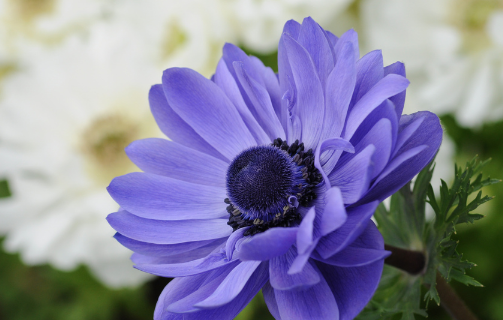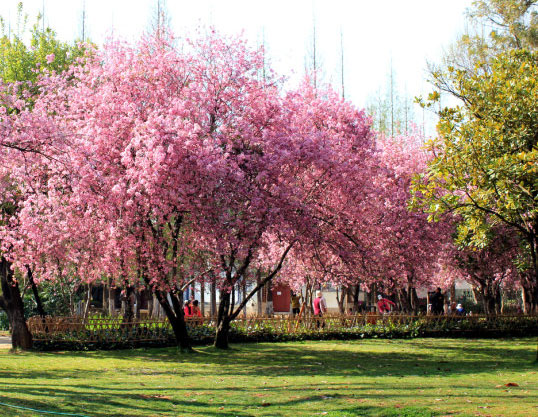Matters needing attention in the culture of anemone
Diseases and insect pests
Anemone will have diseases and insect pests, diseases are mainly rot, blight, gray mold, powdery mildew and so on, the harm is more serious, need timely control, pests are mainly aphids and ground tigers, you can use commonly used pesticides to kill.

Seed collection
Anemone can be sown, and the seeds are usually sown as they are picked. The seeds must be harvested in time, otherwise they will be blown down by the wind, and the harvested seeds should be kept in a ventilated and dry place for maintenance.
Anemone is a very beautiful flower, and it is not difficult to breed. As long as we take care of it carefully, we can get a very charming anemone.
Culture methods and matters needing attention of anemone
Selection of potted soil for cultivation of anemone
In order to cultivate anemone, we can choose the mixed basin soil, mix the garden soil, rotten leaf soil and plant ash according to a certain proportion, and add some base fertilizer, which requires good drainage.
Light and temperature
The cultivation of anemone needs to meet the two conditions of cool and sufficient light. Anemone can be cold-resistant, but avoid high temperature, the suitable temperature for growth is between 15 ℃-35 ℃, the temperature in winter is not less than 10 ℃, it can be safely spent through the winter, it can be put in a sunny place indoors, and can be maintained in a greenhouse if possible.
Watering and fertilizing
Culture anemone, need to keep the soil moist, but watering should be careful, do not make the basin soil too wet, lest the roots rot. The trumpet with less moisture in winter can reduce watering, while in rainy seasons, anemones need to be kept in a dry place, pay attention to shelter from rain, and stop watering. Fertilization is generally applied every half a month thin fertilizer and water, during flowering, in order to promote the formation of flower buds, can be applied once a week.
Reproduction method
The reproduction of anemone is mainly sowing and dividing balls, sowing is autumn sowing, and seeds are sown as they are picked. Bulb reproduction is mainly about the division and planting of anemone bulbs.
Matters needing attention in Anemone Culture Diseases and insect pests
Anemone will have diseases and insect pests, diseases are mainly rot, blight, gray mold, powdery mildew and so on, the harm is more serious, need timely control, pests are mainly aphids and ground tigers, you can use commonly used pesticides to kill.
Seed collection
Anemone can be sown, and the seeds are usually sown as they are picked. The seeds must be harvested in time, otherwise they will be blown down by the wind, and the harvested seeds should be kept in a ventilated and dry place for maintenance.
How to raise anemone? Culture methods and matters needing attention of anemone
Anemone, also known as North China anemone, stamen anemone and so on, is a perennial herb of Ranunculaceae. Anemone flowers are gorgeous, elegant or charming, with high ornamental value, so they are often potted in the indoor courtyard. So, how to raise anemones? The culture methods and matters needing attention of anemone are introduced as follows.
Picture: anemone
I. Culture methods of anemone
1. Pot soil choice: breeding anemone, you can choose a mixed basin soil, garden soil, rotten leaf soil and plant ash according to a certain proportion of mixed, and add some base fertilizer, require good drainage.
two。 Light and temperature: the cultivation of anemone needs to meet the two conditions of cool and sufficient light. Anemone can be cold-resistant, but avoid high temperature, the suitable temperature for growth is between 15 ℃-35 ℃, the temperature in winter is not less than 10 ℃, it can be safely spent through the winter, it can be put in a sunny place indoors, and can be maintained in a greenhouse if possible.
3. Watering and fertilization: to cultivate anemone, it is necessary to keep the soil moist, but watering should be careful not to make the basin soil too wet, lest the roots rot. The trumpet with less moisture in winter can reduce watering, while in rainy seasons, anemones need to be kept in a dry place, pay attention to shelter from rain, and stop watering. Fertilization is generally applied every half a month thin fertilizer and water, during flowering, in order to promote the formation of flower buds, can be applied once a week.
4. Propagation method: the reproduction of anemone is mainly sowing and dividing balls, sowing is autumn sowing, seeds are sown with picking. Bulb reproduction is mainly about the division and planting of anemone bulbs.
Picture: anemone
II. Matters needing attention in anemone culture
1. Diseases and insect pests: anemone will have diseases and insect pests, the main diseases are rot, blight, gray mold, powdery mildew and so on, the harm is relatively serious, need timely control, pests are mainly aphids and ground tigers, you can use commonly used pesticides to kill.
two。 Seed collection: anemone can be sown, generally sowing seeds as they are picked. The seeds must be harvested in time, otherwise they will be blown down by the wind, and the harvested seeds should be kept in a ventilated and dry place for maintenance.
[conclusion] Anemone likes cool, moist and sunny environment, which is cold-resistant but avoid high temperature and humidity, so it needs special attention in the process of maintenance. The above introduces the breeding methods and matters needing attention of anemone, hoping to help you!
- Prev

Maintenance method of Songhongmei in four Seasons
Songhongmei can survive all the year round, and there are some maintenance methods in each season. 1. Provide sufficient light to Songhongmei in spring and spring, but also avoid direct sunlight. After the spring flowering period, we should pay attention to pruning Songhongmei to avoid excessive crown growth and increase the aesthetic function at the same time.
- Next

Making of Bonsai of Begonia
Step 1: prepare potted soil when making crabapple bonsai, we need to choose a suitable flowerpot. In general, we can choose medium-sized deeper flowerpots, which can be square, round, or in the shape we like. Flowerpots are generally made of glazed pottery or purple sand pottery. In the cultivation of flowers
Related
- Fuxing push coffee new agricultural production and marketing class: lack of small-scale processing plants
- Jujube rice field leisure farm deep ploughing Yilan for five years to create a space for organic food and play
- Nongyu Farm-A trial of organic papaya for brave women with advanced technology
- Four points for attention in the prevention and control of diseases and insect pests of edible fungi
- How to add nutrient solution to Edible Fungi
- Is there any good way to control edible fungus mites?
- Open Inoculation Technology of Edible Fungi
- Is there any clever way to use fertilizer for edible fungus in winter?
- What agents are used to kill the pathogens of edible fungi in the mushroom shed?
- Rapid drying of Edible Fungi

